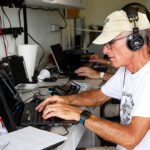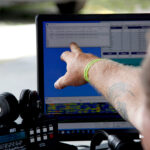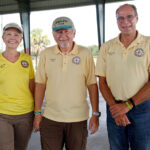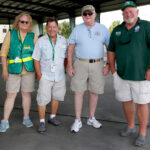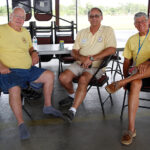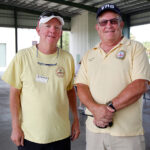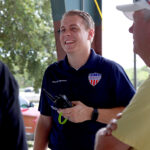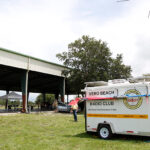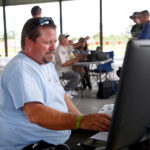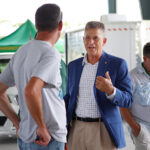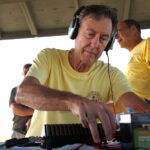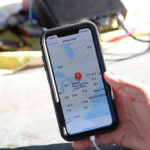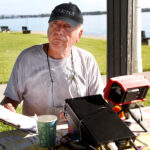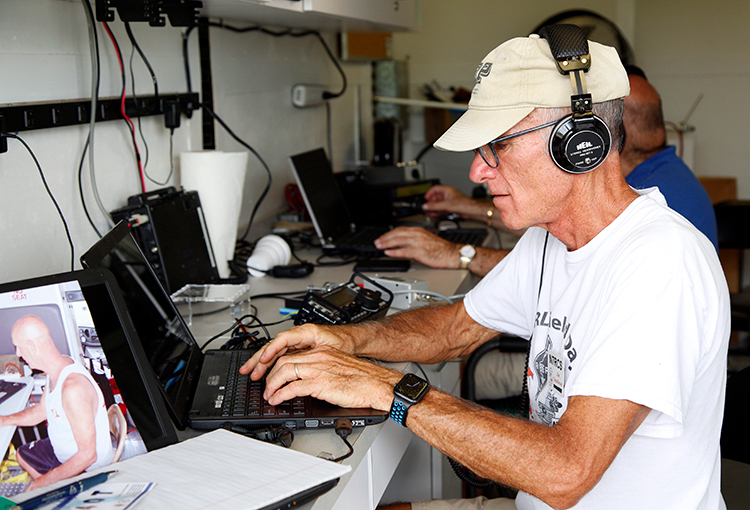
Earlier this summer, members of the Vero Beach Amateur Radio Club gathered at the Indian River County Fairgrounds to participate in an annual Amateur Radio Field Day, “hamming” it up for local residents and showing what they can do. During the two-day field exercise, members took shifts to test long-distance communications by attempting to reach fellow operators in all 50 states.
Amateur radio hobbyists have communicated via radio signals since the early 1900s and were often mocked for their “ham fistedness” by professional telegraphy operators. Today, operators embrace the ‘ham’ nickname, having proven their value and dedication to communities across the globe.
Ham radio operators use small frequency bands to transmit non-commercial voice, text, image and data communications to fellow operators around the world, and even into space.
Users must be licensed, falling into three levels of certification depending on the frequencies they wish to use. They must also follow standard Federal Emergency Management Agency protocols in order to provide communication support in other locations in times of crisis.
Equipment to set up a ham shack ranges anywhere from $35 to thousands, says Greg Wagner, VBARC public information officer.
“These days, you can pick up a decent handheld radio that will cover all of our Amateur Radio Emergency Service nets and frequencies for as little as $35, if you just want to be available and help out in the community,” he explains.
The club, founded 60 years ago, is 100 members strong, with members coming from all walks of life. They continue to be an invaluable source of assistance, providing equipment and skilled operators during emergencies by assisting the Office of Civil Defense, the Emergency Management Division of Indian River County, and the Red Cross.
When a natural disaster is imminent, members are assigned to local people and pet shelters, hospitals and the Emergency Operations Center, to ensure continuous communication in the event that telephone and cellphone towers go down and infrastructure fails. Prior to a storm hitting, they set up a net – an “on-the-air” gathering of operators – so that they are in place beforehand.
“It’s our job to make sure that the counts at the shelters are correct and determine if the shelters need anything. All of that information is relayed to the Emergency Operations Center of Indian River County, where we have three operators operating radios 24 hours a day,” Wagner explains.
The operators can also advise family members who have been unable to reach their loved ones post-disaster, that they are safe.
In the club’s early days, they were called upon to provide emergency communications in the Dominican Republic during the 1965 Dominican Civil War. More recently, they assisted during hurricanes Frances and Jeanne in 2004, Hurricane Wilma in 2005 and Hurricane Matthew in 2016.
But it’s not just emergencies. The club also provides radio communications along the routes of local parades, races and walks, such as the Vero Beach Centennial parade, Vero Beach Triathlon, Gator Gallop and the Thanksgiving Day Trot Against Poverty. Members are able to transmit calls for emergency support for anyone who has sustained an injury.
Participating in those types of events actually help them to remain ready for emergencies.
“Those [events] are all done with what we would call off-the-grid power,” says Wagner. “We don’t use electricity for any of that. It’s all battery- or generator-powered, to simulate what would happen if we were hit by a severe hurricane.”
The club was designated as an American Radio Relay League Special Services Club in 2017, acknowledging the members’ willingness to go above and beyond for the community and amateur radio by providing active training classes, publicity programs, technical projects and operating activities.
They conduct activities on a weekly and monthly basis to keep members’ skills fresh and their interest peaked. On Saturday mornings, you can find them at the A.W. Young Park, where they test and tune equipment, transmitting at reduced power while attempting to maximize the effective range.
During a recent gathering, Richard Jackson, a charter member, contacted other ham radio operators as far away as the Slavic Republic, Poland, Germany, Italy and Canada. Members have also communicated with the space station on occasion.
“Even if I’m by myself and don’t make a contact, this charges my internal battery. Where else can you get something more peaceful and inspiring than that?” asks Jackson, pointing to the lagoon.
“When I first got involved with ham radio, you had a receiver and a transmitter and they took up a whole desk,” says Jackson.
Pointing to his QRP setup he adds, “this thing here is low power, but I can boost it to give it a little bit more power, and I can put all of it in a bag and set up anywhere.”
Holding his cellphone up, Rick Wykoff demonstrates that he can communicate from his phone through the ham radio setup he has at his home across town.
Next up is the Dec. 4 Treasure Coast Ham Fest at the Indian River County Fairgrounds, to which the public is invited. The club meets at 7:30 p.m. at the Italian American Club on the second Thursday of each month and can often be found from 8 a.m. to 12 p.m. Saturdays at A.W. Young Park.
For more information, visit w4ot.webs.com.
Photos by Kaila Jones

